A floating apparition on Lake Seliger: St. Nilus Monastery
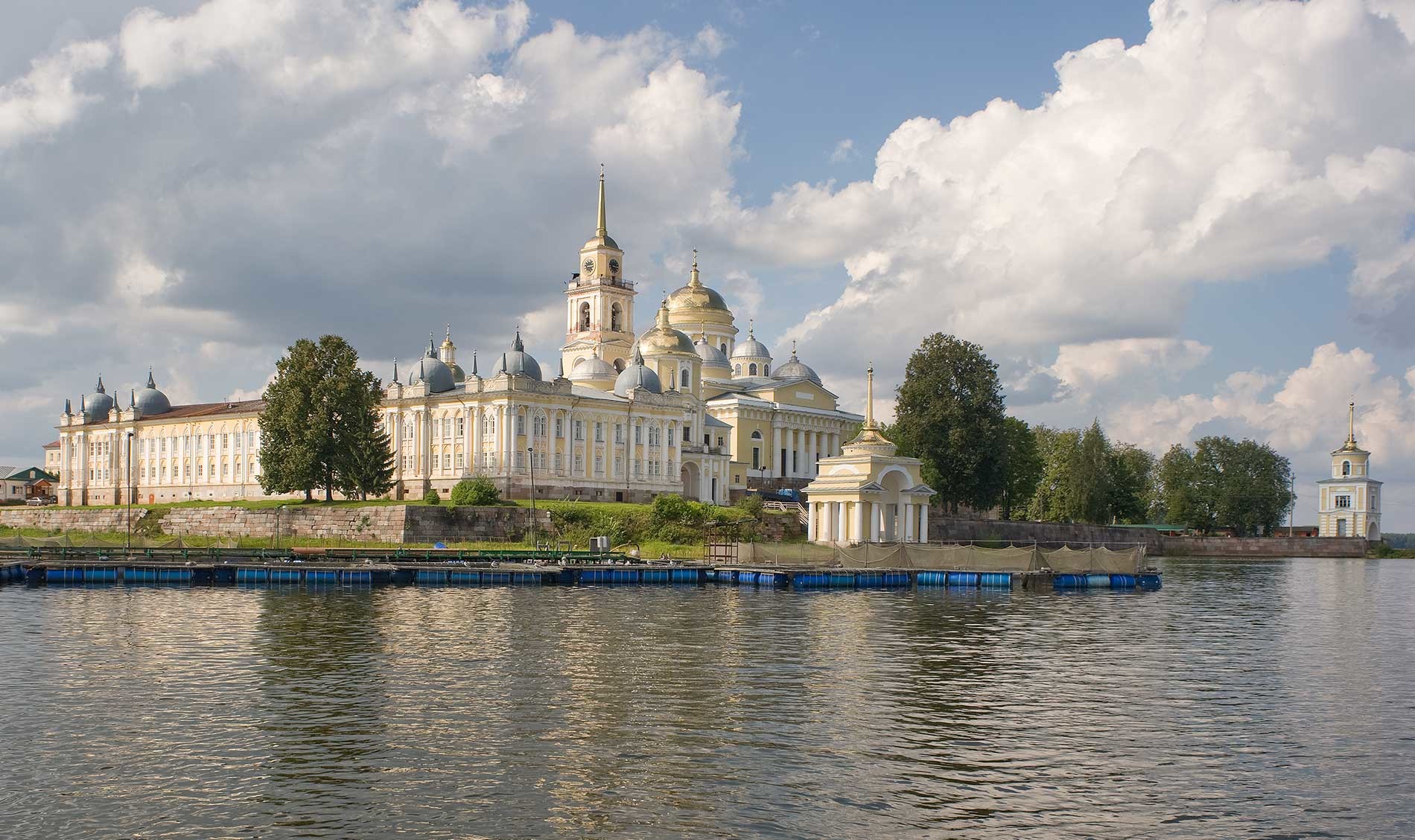
Nilova Pustyn, St. Nilus Stolobensky Monastery. Southeast view from Lake Seliger. Aug. 23, 2016.
William BrumfieldAt the beginning of the 20th century, Russian chemist and photographer Sergei Prokudin-Gorsky developed a complex process for vivid color photography (see box text below). His vision of photography as a form of education and enlightenment was demonstrated with special clarity through his images of architectural monuments in the historic sites throughout the Russian heartland.
In 1908, Prokudin-Gorsky arranged screen showings of his color images to various groups in St. Petersburg, including members of the imperial court and the State Duma. After a meeting with Emperor Nicholas II in May 1909, Prokudin-Gorsky’s project received official support from the Ministry of Transportation, which facilitated his photography along Russia’s rail and waterways.
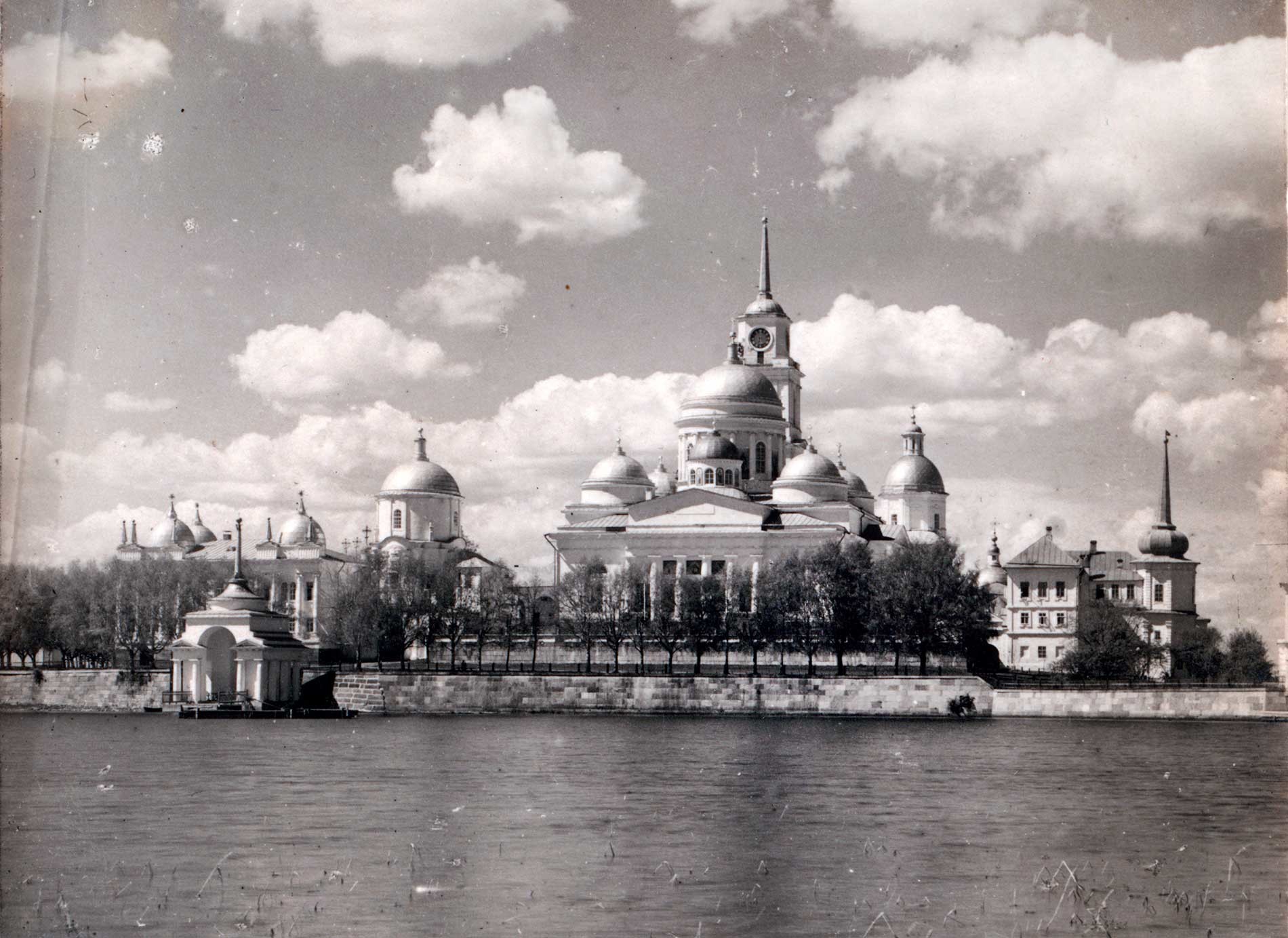
Nilova Pustyn, east view from small island. From left: Archbishop's Landing, Archbishop's Chambers, Church of St. Nilus Stolobensky over East Gate, Epiphany Cathedral&bell tower, Church of SS. Peter&Paul over West Gate, Church of All Saints, Refectory. Summer 1910.
Sergei Prokudin-GorskyAmong the most breathtaking of Prokudin-Gorsky’s striking photographs are those he took in the summer of 1910 of the St. Nilus Stolobensky Monastery in the Tver Region. Located on a small island in Lake Seliger, the monastery possesses a special lyrical appeal in the midsummer, when the shores of Stolobny Island are fringed with reeds and water lilies. My photographic work there dates from August 2016, more than a century after Prokudin-Gorsky’s visit.
Guided by prayer
The guiding spirit of Nilova Pustyn (as it is often called in Russian) was the monk Nilus, born in the Novgorod region in the late 15th century. Orphaned at an early age, he entered the
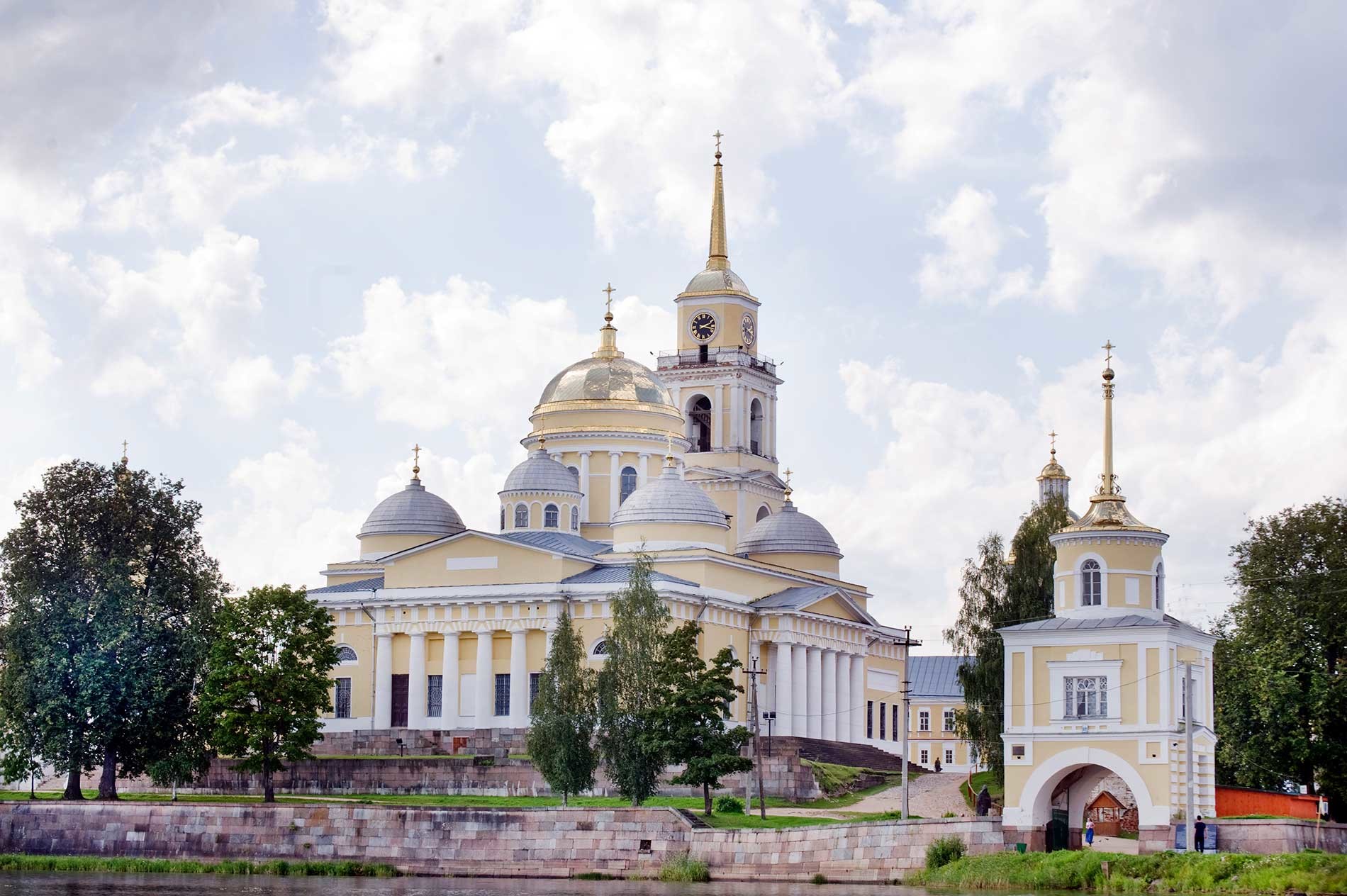
Nilova Pustyn, east view from Svetlitsa village. Epiphany Cathedral & bell tower, Svetlitsa Tower. Aug. 23, 2016.
William BrumfieldAs word of Nilus’ saintly reputation spread, he was visited by those who sought his blessing and prayers. After 13 years in the
Following St. Nilus’s death, a group of monks gathered on the island under the guidance of the monk Herman from the nearby St. Nicholas-Rozhkovsky Monastery. Herman and others erected a log church dedicated to the Epiphany in 1591-94, and shortly thereafter Patriarch Job gave his blessing to the Nilova Pustyn community.
A complex constructed and reconstructed
Over the next 150 years, the monastery endured many
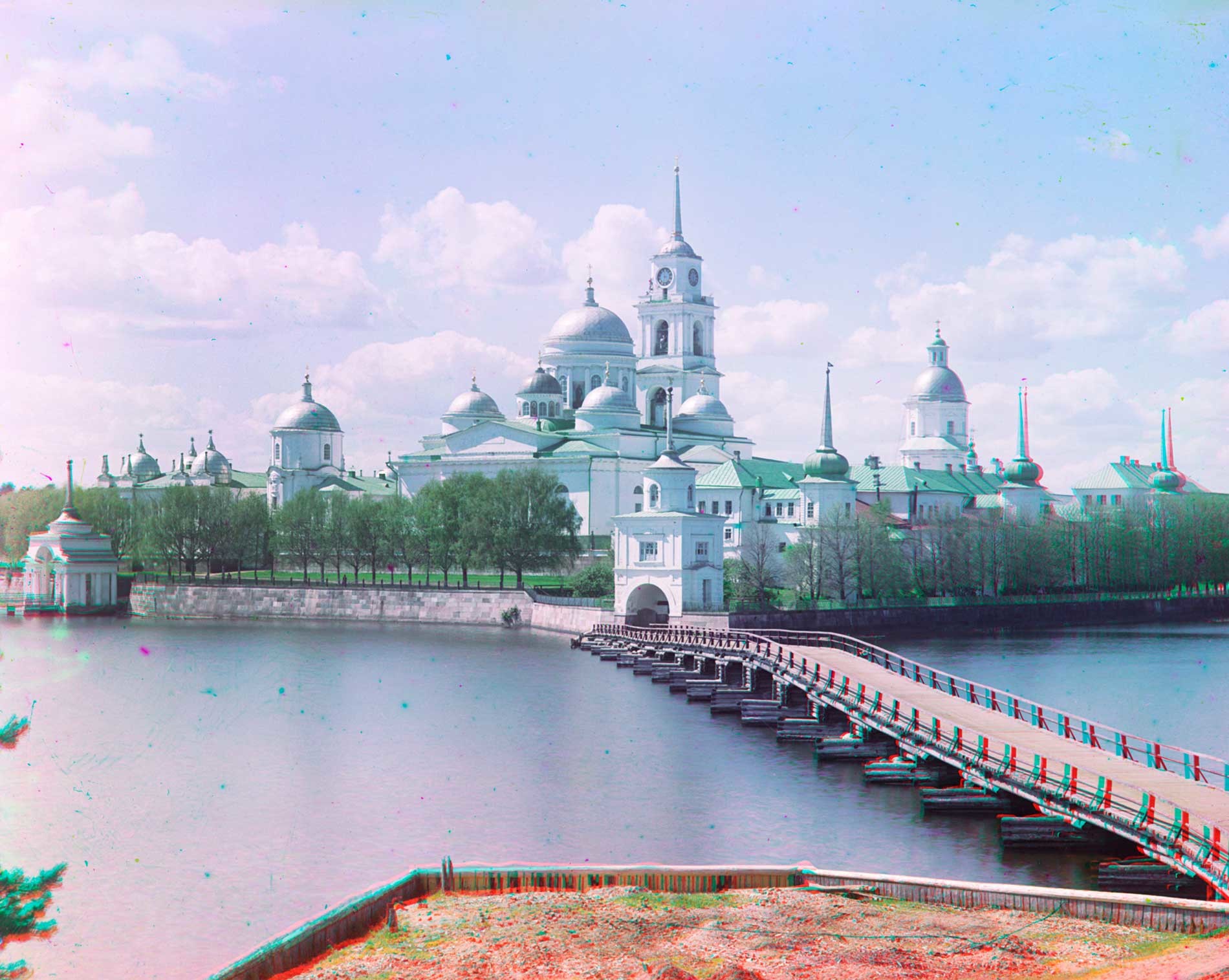
Nilova Pustyn, northeast view from Svetlitsa village. From left: Archbishop's Landing, Archbishop's Chambers, Church of St. Nilus over East Gate, Epiphany Cathedral&bell tower, Svetlitsa Tower, Refectory, Church of SS. Peter&Paul over West Gate. Summer 1910.
Sergei Prokudin-GorskyThe oldest surviving church within the monastery was built in 1699-1700 next to the monastery infirmary and dedicated to St. Nilus. Re-consecrated in 1723 as the Church of All Saints, it was modified during
Most of the existing churches were rebuilt over several decades beginning in the middle of the 18th century. Among the better preserved is the Church of St. Nilus Stolobensky, a Baroque structure built in 1751-1755 over the East Gate.
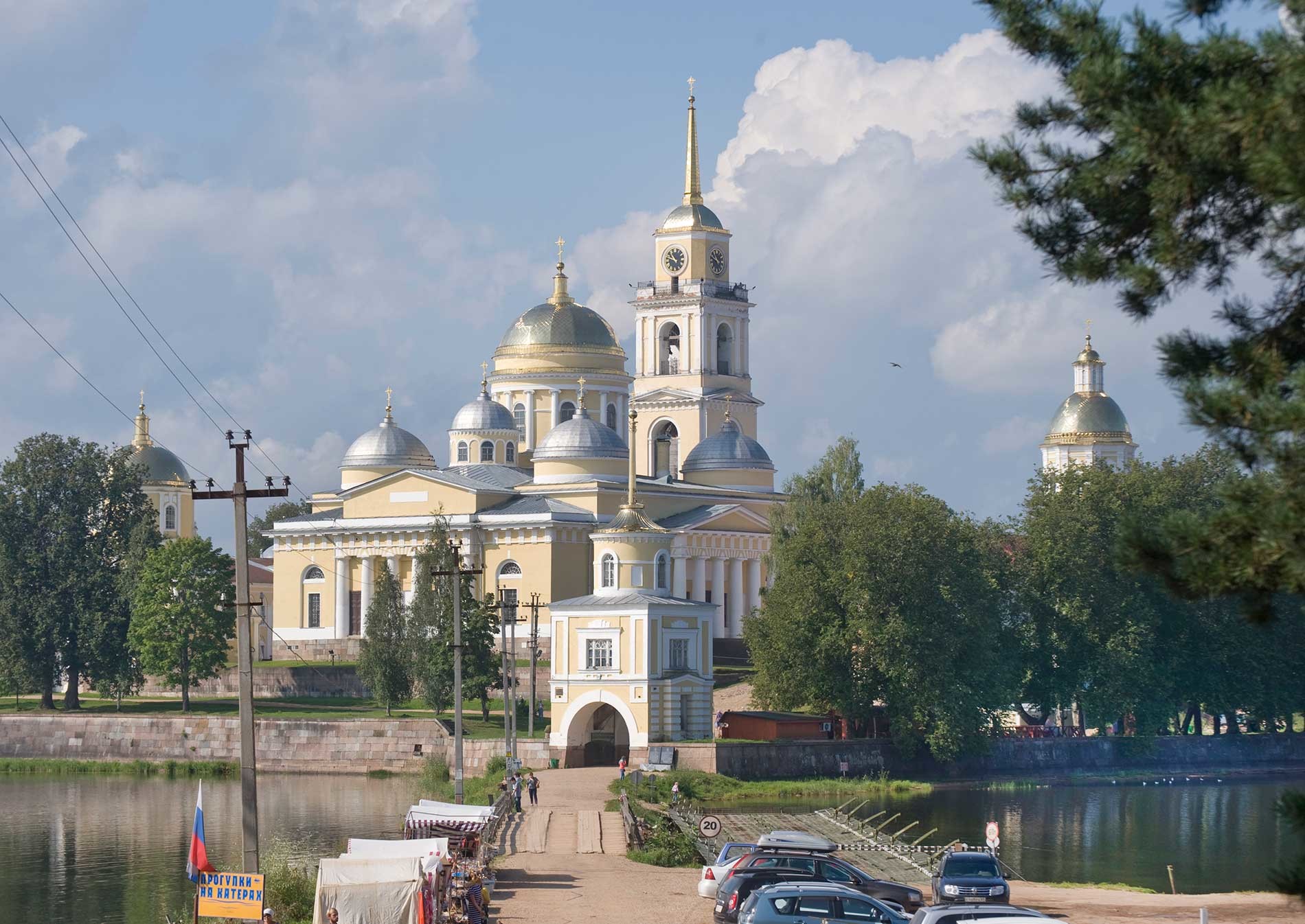
Nilova Pustyn, northeast view from Svetlitsa village. From left: Church of St. Nilus over East Gate, Epiphany Cathedral&bell tower, Svetlitsa Tower, Church of SS. Peter&Paul over West Gate. Aug. 23, 2016.
William BrumfieldThe main square is dominated by the Epiphany Cathedral and its bell tower. Since the end of the 16th century, there had been an Epiphany Church on the island, but over the centuries, it was rebuilt as the monastery expanded.
The monastery received a visit from Emperor Alexander I in May 1820, and the following year, work began on the present cathedral, a grand neoclassical structure conceived by the great Carlo Rossi, but completed by another major St. Petersburg architect, Joseph-Jean Charlemagne (1782-1861). The cathedral was consecrated in
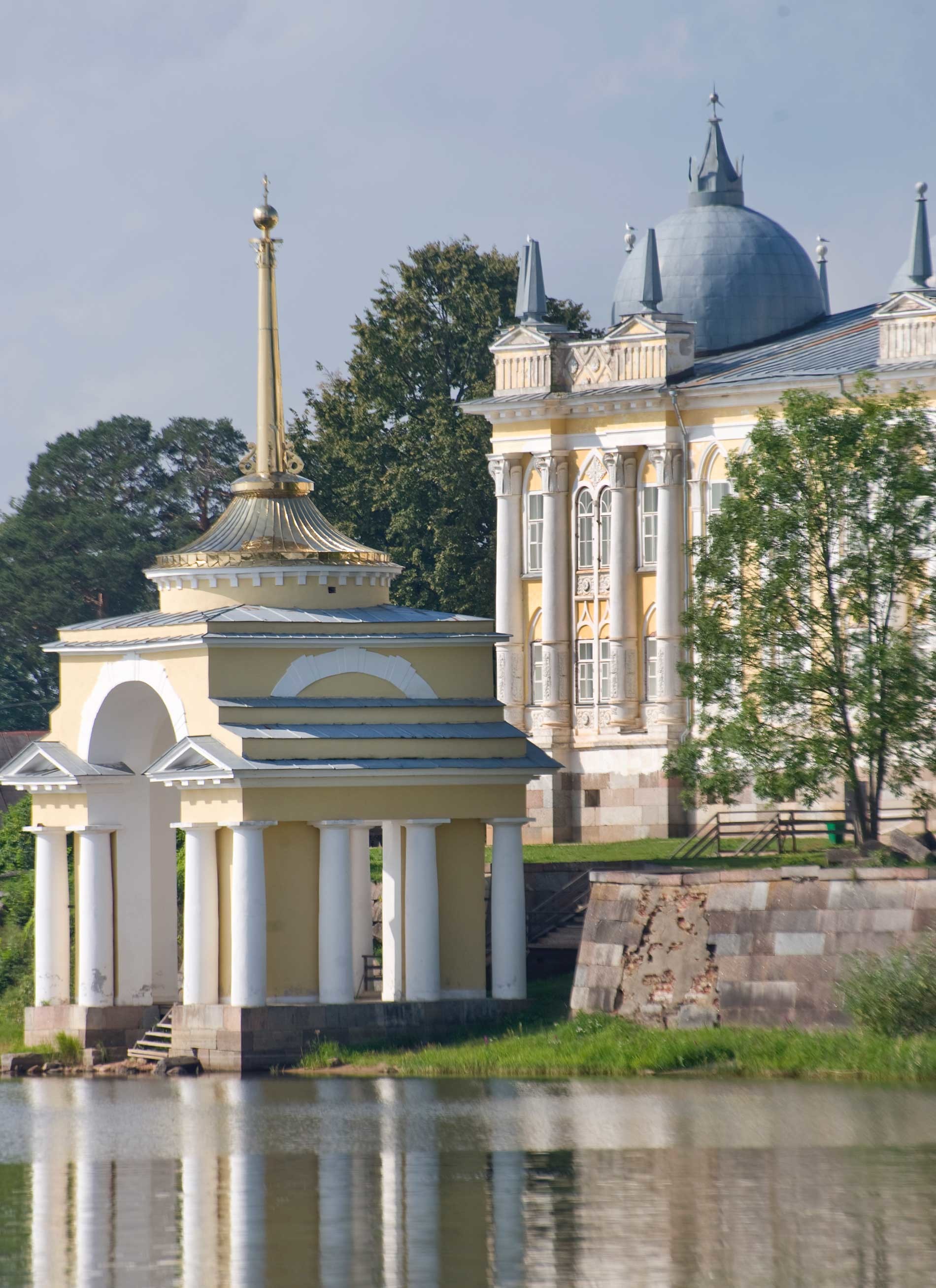
Nilova Pustyn, northeast view from Svetlitsa village. Archbishop's Landing, Archbishop's Chambers. Aug. 23, 2016.
William BrumfieldDuring the first half of the 19th century, other components of the ensemble were completed, including the exquisite Doric-style Archbishop’s Landing (1814) as well as the imposing south cloisters and Bishop’s Chambers, which were designed in a mixture of the neoclassical and the Gothic Revival styles. The sense of imperial St. Petersburg was amplified by the massive granite foundations and embankments
All these monumental structures are visible in Prokudin-Gorsky’s remarkable photographs. Especially informative is the view toward the island ensemble from the village of Svetlitsa, with a wooden causeway leading to the immaculate grounds of the monastery. A broader view was taken from the village of Peski to the southeast.
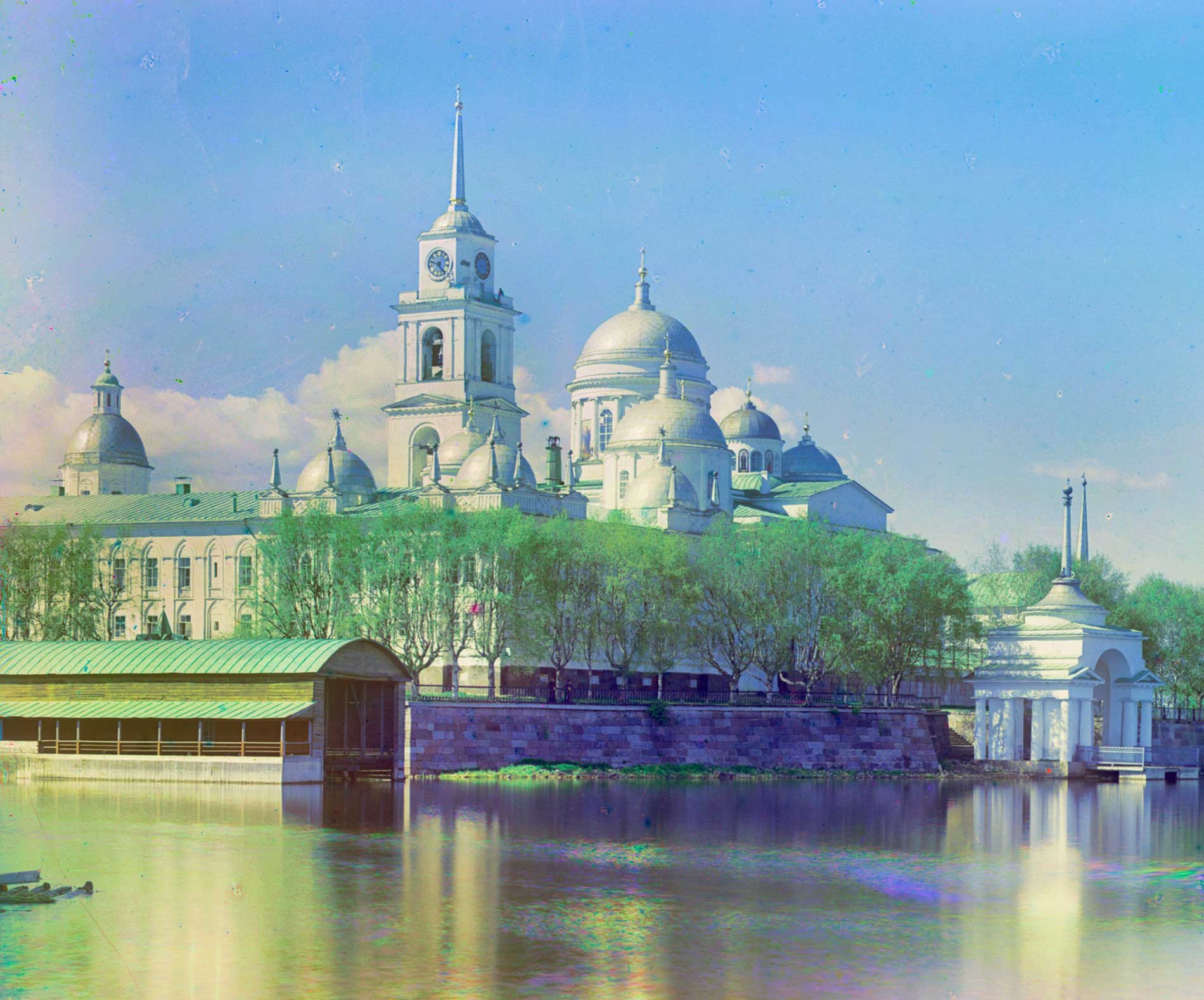
Nilova Pustyn, southeast view from east cape of Stolobnyi Island. From left: Church of SS. Peter & Paul over West Gate, South Cloisters & Archbishop's Chambers, bell tower & Epiphany Cathedral, Church of St. Nilus over East Gate, Archbishop's Landing. Summer 1910.
Sergei Prokudin-GorskyIn August 2016, I took similar views from the water in a small boat provided by the monastery. The long exposures required by Prokudin-Gorsky’s color process could only be taken on a stable land base. (My Nikon camera allowed greater flexibility.) Fortunately, he was able to find suitable viewpoints from nearby shores.
Both Prokudin-Gorsky and I benefited from the summer clouds that hovered over Lake Seliger. They are almost motionless in the still air. This stillness was particularly beneficial for

Nilova Pustyn. Southeast view from Lake Seliger. South Cloisters & Archbishop's Chambers, bell tower&Epiphany Cathedral, Church of St. Nilus over East Gate, Archbishop's Landing. Aug. 23, 2016.
William BrumfieldSoviet-era prison and military hospital
Following the Bolshevik Revolution, the monastic ensemble was subjected to widespread vandalism. Closed in 1928, it was often used as a place of incarceration. The area around the monastery was near the front lines during World War II. Battles in the area began in Fall 1941 and lasted until January 1943. The monastery itself was used as a military hospital throughout the war. From 1945 to 1960, it again housed juvenile delinquents, then for a decade, was used as a home for the elderly.
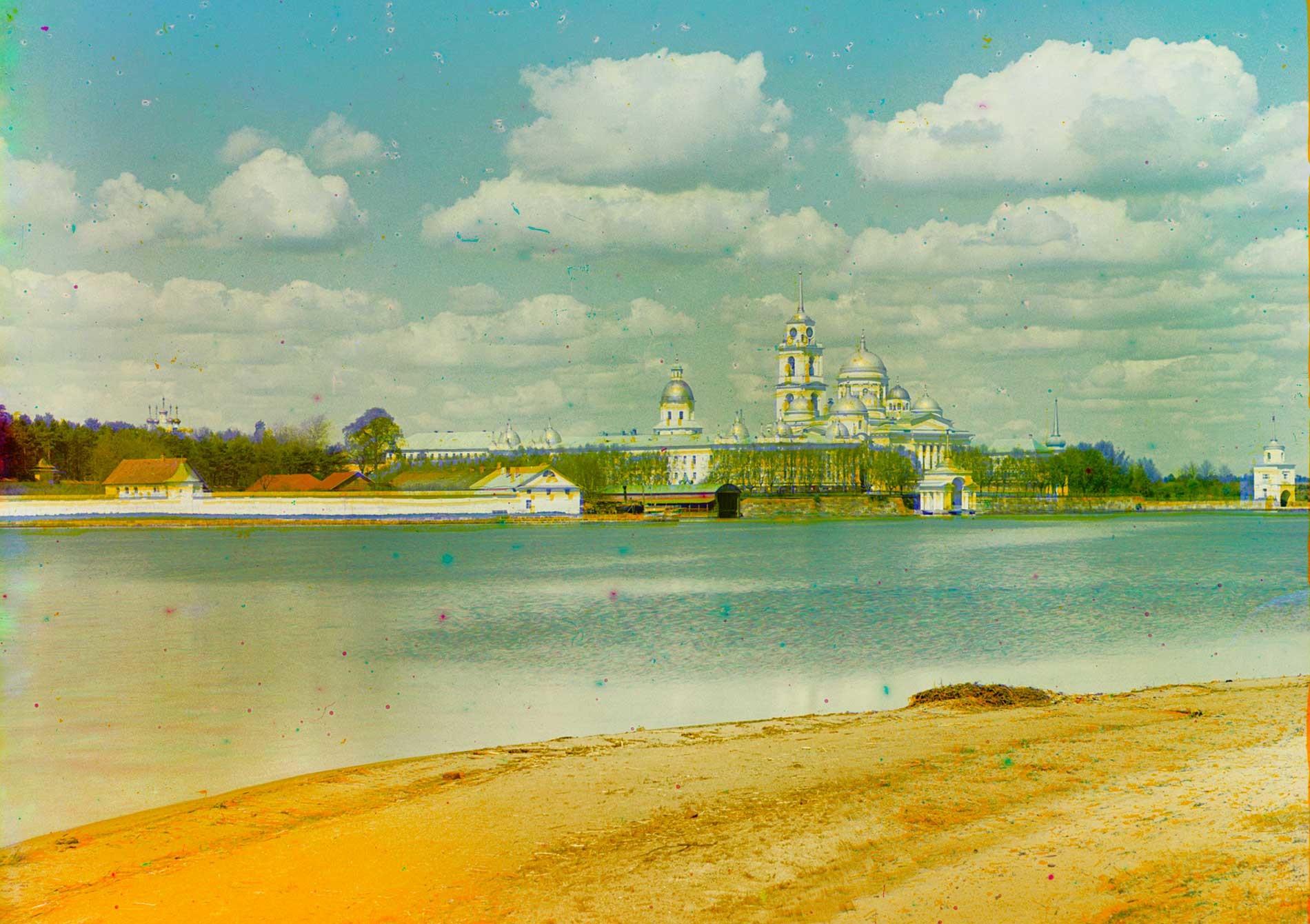
Nilova Pustyn. Southeast view from Peski village. From left: Church of John the Baptist (not extant), workshops, Church of SS. Peter&Paul, South Cloisters&Archbishop's Chambers, bell tower&Epiphany Cathedral, Church of St. Nilus, Archbishop's Landing, Refestory, Svetlitsa Tower. Summer 1910.
Sergei Prokudin-GorskyIn 1990, the territory of the monastery was returned to the Orthodox Church, and the following year, the first liturgy was celebrated in a section of the Epiphany Cathedral. In 1995, the relics of St. Nilus were returned to the Epiphany Cathedral from the Ostashkov Museum.
The restoration of the architectural ensemble has required prolonged effort, but each year brings significant progress. Throughout this
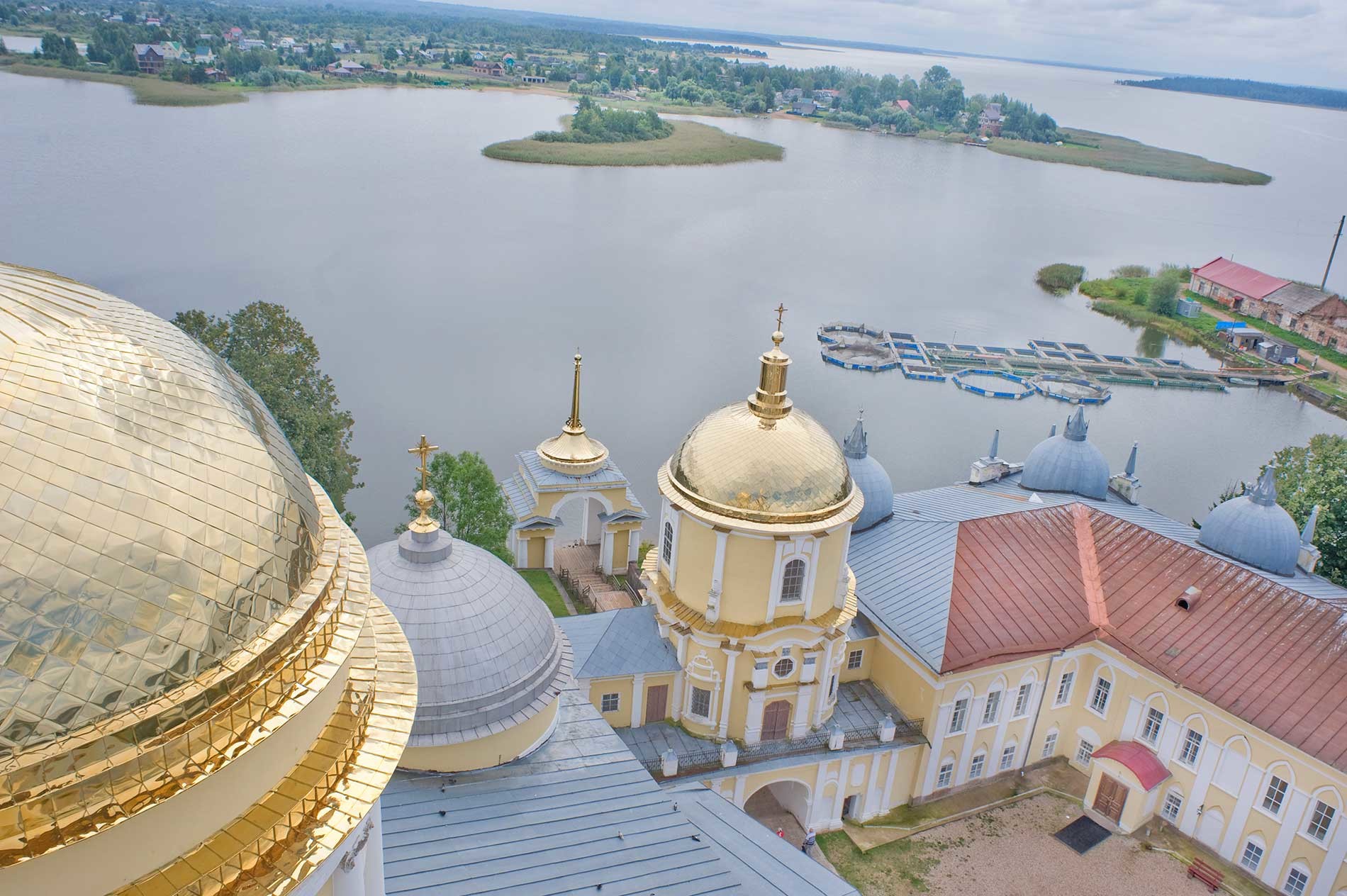
View toward southeast from Epiphany Cathedral bell tower. Foreground: Archbishop's Landing, Church of St. Nilus over East Gate, Archbishop's Chambers. Right: Fish farm, warehouses&east cape of Stolobnyi Island. Background: Lake Seliger, Liapino village (former Peski). Aug. 24, 2016.
William BrumfieldIn the early 20th century the Russian photographer Sergei Prokudin-Gorsky devised a complex process for color photography. Between 1903 and 1916 he traveled through the Russian Empire and took over 2,000 photographs with the process, which involved three exposures on a glass plate. In August 1918, he left Russia and ultimately resettled in France with a large part of his collection of glass negatives. After his death in Paris in 1944, his heirs sold the collection to the Library of Congress. In the early 21st century the Library digitized the Prokudin-Gorsky Collection and made it freely available to the global public. A number of Russian websites now have versions of the collection. In 1986 the architectural historian and photographer William Brumfield organized the first exhibit of Prokudin-Gorsky photographs at the Library of Congress. Over a period of work in Russia beginning in 1970, Brumfield has photographed most of the sites visited by Prokudin-Gorsky. This series of articles will juxtapose Prokudin-Gorsky’s views of architectural monuments with photographs taken by Brumfield decades later.
If using any of Russia Beyond's content, partly or in full, always provide an active hyperlink to the original material.
Subscribe
to our newsletter!
Get the week's best stories straight to your inbox